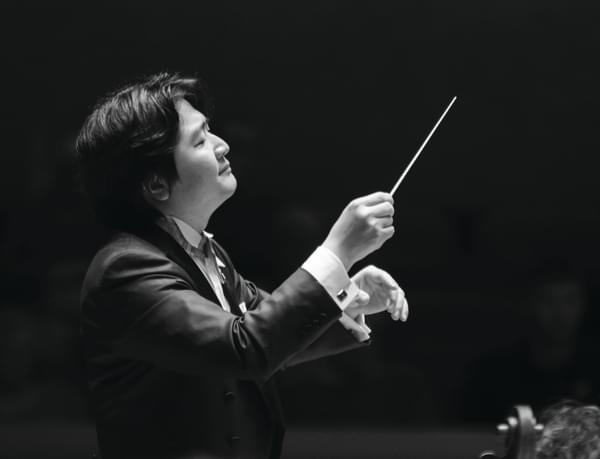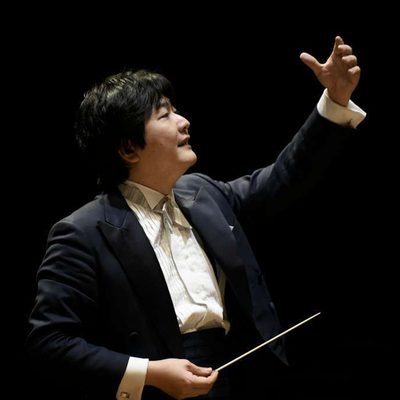Kazuki conducts Mahler 9

Full programme
- Takemitsu, Requiem (8mins)
- Mahler, Symphony No.9 (87mins)
Performers
Introduction
I am really looking forward to this concert - what a great coupling of music: Takemitsu’s Requiem and Mahler’s Ninth Symphony. The obvious theme of this concert is death but these two pieces are like a dialogue between this world and heaven, asking the simple question: ‘Where do we go after death?’ It’s life’s biggest question and these two pieces attempt to answer it through the power of music.
Takemitsu’s Requiem was written when he was in his twenties and was very sick. He thought he was on his deathbed and so wrote this piece for himself. Almost nobody knew of Takemitsu’s work when he wrote but Stravinsky heard this Requiem in concert and commented on the speciality and uniqueness of Takemitsu’s sound. It was through this appraisal that Takemitsu’s Requiem became a turning point in his career. It was the first of his pieces to gain him popularity and reputation in the music scene.
Mahler also expected his death to be very near when he wrote this symphony. He was very superstitious and believed in the ‘curse of the ninth’ because Beethoven, Schubert and Bruckner had all passed after their ninth symphony. Therefore, he refused to call his previous work Das Lied von der Erde his ninth symphony and rather reluctantly completed this ninth symphony, which later did turn out to be his last!
Mahler never heard the premiere of his piece, so I often wonder how the piece sounded in his imagination outside of what’s written on the score. He was interested in the philosophy of the cyclical pattern on life: how life moves continuously from birth to death - life always continues. We can feel this philosophical message from the very start of the symphony to the finale. The orchestral texture builds from the start and then gradually gets less and less towards the end, the orchestra playing five notes, then four until they reach just one note and then complete silence. It is such a meaningful piece of work and I’m sure will bring a very emotional end to the concert.
Life is not easy, but even in the difficult moments we can feel the happiness and beauty of life and I couldn’t think of two pieces that describe this feeling better.
Kazuki Yamada
Music Director
Programme Notes
Takemitsu’s Requiem and Mahler’s Symphony No.9 were triggered by loss and grief – Takemitsu for his mentor Fumio Hayasak, Mahler for his own daughter. But in the midst of death there is life: despite the solemn circumstances, these works have incredible spirit, even joy at times.
Requiem
Toru Takemitsu (1930-1996)
“I think music must be a form of prayer” wrote Toru Takemitsu, asked to describe his first major orchestral work, the Requiem (1957) for string orchestra. “I’m not a Catholic. I titled my first piece Requiem because we were bereaved of our people in the war – not only the Japanese, but the whole world. Now, my musical style is different since I did Requiem, but my idea is still reflected in my music, and I’m very happy I have not a specific religion. My god is everywhere, in a thicket of trees, in the people, and in a Coca Cola bottle”.
It’s an observation that reflects upon Takemitsu’s whole creative aesthetic. He came from an established tradition of Japanese composers using western instruments and studied privately in Tokyo with the composer Yasuji Kiyose, (1900-1981) but was largely self-taught, listening to western classical music on American radio. After a long period of experimentation with electronic music, his Requiem captured the world’s attention almost by accident. When Stravinsky visited Japan in 1959, NHK radio invited him for a studio interview and accidentally confused a recording of the Requiem with one of Stravinsky’s own works.
The producer tried to turn it off, but Stravinsky, captivated, insisted on listening to the end – fascinated, he said, by the music’s “passionate writing” and “sincerity throughout”. It was, he said, a “masterpiece”, and he asked to meet Takemitsu for lunch. Those same qualities – the Requiem’s perfect economy, its concentrated poetry and its eloquent, universal emotion – speak just as loudly (and softly) today.
Symphony No.9
Gustav Mahler (1860–1911)
I. Andante comodo
II. Im Tempo eines gemächlichen Ländlers
III. Rondo - Burleske
IV. Adagio
Gustav Mahler composed his Ninth Symphony – unusually, for him – in a single summer. It was 1909. Having returned from New York, where he was chief conductor of the Metropolitan Opera, he had taken his wife Alma to the health spa at Levico and had returned alone to a rented house in the Alpine countryside near Toblach (modern Dobiacco), where he’d spent the previous summer completing his song-symphony Das Lied von der Erde. The Mahlers had owned their own summer home on Lake Worthersee, but had left it forever after the devastating summer of 1907, when in a few short weeks they had lost their little daughter Maria and Mahler himself had been diagnosed with a life-threatening heart condition.
Now, alone in the woodland hut that he used as a private study (and which Alma called, mockingly, his “earth closet”) he composed. “He was disturbed by no-one” recalled his landlord’s daughter. “At the break of dawn his breakfast had to be laid out: tea, coffee, butter, honey, eggs, rolls, fruit and poultry. Director Mahler would start work at 6am. There was a stove in the hut; he would light it himself and prepare his meal on it…” It wasn’t all monastic seclusion and fresh produce. Eventually Alma joined him; and there were visitors, including the teenage composer Erich Korngold and Mahler’s colleague Richard Strauss, who was eager to play him his new opera Elektra but less interested in Mahler’s own newly-completed symphony.
Still, Mahler seems to have worked quickly, and Alma believed that he felt relieved of a psychological burden: his superstition that Ninth Symphonies were cursed to be their composer’s last. By composing Das Lied von der Erde – a ninth symphony in all but name – he was convinced he’d cheated fate. The only time he mentioned the new symphony in writing was in a single letter to his friend and protégé, the young conductor Bruno Walter, in August 1909:
"I have been working very hard and am just putting the finishing touches to a new symphony. Unfortunately my holiday is also nearly finished…the work itself (as far as I can tell, because I’ve been writing blindly away at it, and now that I’ve begin to orchestrate the last movement, I have forgotten the first) is a very satisfactory addition to my little family. In it, I say something that has been on the tip of my tongue for some time…"
He makes it sound so modest. Then – as now – the musical world moved slowly, and Mahler had commitments back in the USA. Walter didn’t see the score until after Mahler’s death in May 1911, and he didn’t have a chance to conduct it until 26 June 1912 – when it was played by Mahler’s own former orchestra, the Vienna Philharmonic. Mahler’s sudden death had hit Vienna’s musicians hard, and this posthumous premiere rapidly became a major occasion, with an audience that included the young avant-garde composer Alban Berg.
"The most wonderful music Mahler ever wrote" was Berg’s verdict; he heard in the symphony both "remarkable love for this world" and "a foreboding of death". That first performance marked the birth of a Mahler cult in Vienna, and for Berg’s generation, every performance of the symphony was an event. In January 1938, the British record producer Fred Gaisberg heard that Walter was to perform the Ninth with the Vienna Philharmonic and persuaded his employers HMV to let him take the train out to Vienna to record it live. Just weeks later, Hitler’s troops marched into Austria. Mahler’s music was banned in his own country and Jewish musicians were dismissed. Listening to this urgent, heartbreaking premiere recording, the Ninth Symphony can feel like a farewell to a life, an era, and a whole civilisation.
Would Mahler have agreed? He must have suspected that this would be his last completed symphony (though he was soon at work on another). Certainly, he’d lived through profound tragedy and knew that his own health was dangerously weak. And he peppered his score with emotionally charged instructions – Mit Wut (with anger), schattenhaft (shadowy), wie ein schwerer kondukt (like a solemn funeral procession). Fanfares, waltzes and snatches of hymns weave their way through the music, inviting us to imagine our own meanings and pictures. Then there’s the beginning and ending. The symphony opens with a sighing, two-note theme that Walter thought (and Mahler may have backed him up on this) represented the word leb’ wohl (farewell). It ends with – well, see what you think: it leaves few listeners unmoved.
What’s certain is that Mahler would have asked only that we listen - and, ideally, respond with an open heart. Some have heard the quiet, faltering opening rhythm as a representation of Mahler’s own uneven heartbeat, but after the yearning first melody, the first movement opens out into a huge, circular survey of Mahler’s world and emotions, by turns tender, ghostly, passionate, violent and nostalgic. The second movement is a dance, sometimes playful, sometimes brilliant, sometimes graceful. Earthy folk-dance (ländler) leads to graceful minuet and whirling Viennese waltz, pausing only to change gear or to squeeze every last drop of bittersweet longing from this brief moment of escape.
Trumpets announce the third movement, which Mahler called a Burleske – a joke with a fierce satirical bite, charged with the hectic, anxious gaiety of military bands. Suddenly the whirlwind pauses, the skies clear and with a hymn-like melody a lone trumpet reveals a new and radiant vista before the clarinets shriek and turmoil sweeps over us again. But that beautiful vision returns, deep inside the huge, slow finale – which starts with a great, passionate cry for the strings, and after saying everything its heart has to say, begins a long, breathless fade to silence. A parting song for love, music, sorrow and life? Or a journey towards a beauty too profound even for the art to which Mahler had devoted his whole existence? Berg and Bruno Walter each had their own answers. Mahler hoped that you would find your own.
© Richard Bratby
